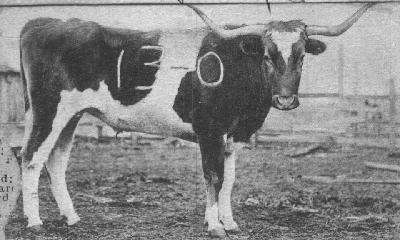Cook ‘Em Horns
Even casual fans of college sports know that the nickname of University of Texas athletic teams is the Longhorns, a reference to a breed of cattle common to the region. But that wasn’t always the case. A century ago, the school’s mascot was a pit bulldog named Pig. If college football had been prominent back then, Texas fans today would be rooting for the dogs.
The mascot switch occurred in 1916. That year, group of alumni collected $124 (about $2,500 in today’s dollars) and purchased a steer named Bo, giving it to the university. At some point, Bo was renamed Bevo, although it’s unclear when or why. As of 2014, we’re on Bevo XIV, because steer don’t live forever. The demise of Bevo I, though, has a special tale.

Texas and in-state rival Texas A&M have met on the football field more than 100 times since their first tilt in 1894. (They’re unlikely to meet again any time soon, as fans know all too well.) Texas leads the series, 76-37-5, but one of those 37 losses was particularly brutal — it was a 13-0 shutout on November 19, 1915. A year or so later, a group of Aggies decided to ensure that Longhorn fans wouldn’t forget the triumph. Word spread that Texas was planning to brand Bevo with a big letter “T” on one side and the numbers “21-7” on the other — the score of the 1916 game in which Texas triumphed — so a handful of A&M students preemptively broke into Bevo’s stable on February 12, 1917 and branded the steer with “13-0.”
Six weeks later, the United States entered World War I.
International military affairs don’t often concern college mascots, but in this case the trickle-down effect had dire implications for Bevo. The war effort was financially taxing, and universities—like everyone else—were feeling the budgetary crunch. Further, the well-being of the now-branded Bevo had become less of a priority for UT. By 1919, despite the conclusion of the war, Bevo’s care was an afterthought and his upkeep—annual care was roughly equal to his original purchase price—had become a point of contention. After all, he was a permanent reminder of a loss.
So they turned him into dinner.
According to UT History Central:
Since food and care for the animal was costing the University fifty cents a day [that’s about $2,400 annually, accounting for inflation], and because the steer wasn’t believed to be tame enough to roam the campus or remain in the football stadium, it was fattened up and became the barbecued main course for the January 1920 football banquet.
But the Aggies ended up benefiting from the prank, too: A&M’s team was invited to the dinner, and the Longhorns didn’t just feed them—they also gave them the hide bearing the “13-0.”
Bonus Fact: The Arkansas School for the Deaf’s mascot is the Leopard. (Get it?)
From the Archives: Keggy: The best NCAA mascot. Even if he’s unofficial.
Related: A relatively new book on college football rivalries. Unreviewed.
This article was originally published on SportsIllustrated.com
